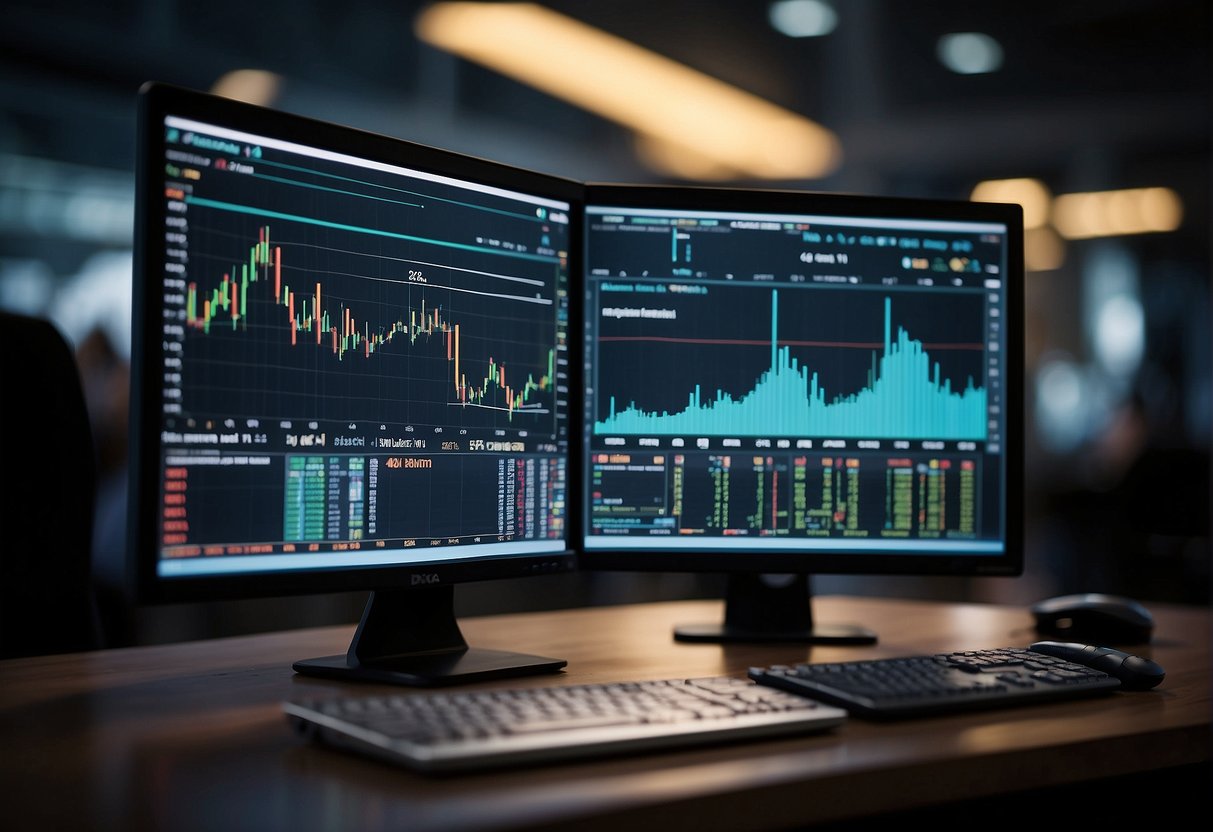Dollar-cost averaging (DCA) is an investing strategy that involves consistently investing equal amounts of money at regular intervals, regardless of the asset’s price. This approach mitigates the impact of market volatility, making it suitable for investors looking to minimize risks and grow their investments over time. However, staying disciplined and following a DCA strategy can be challenging for individuals, especially in rapidly changing market conditions. That’s where dollar-cost averaging trading robots or DCA bots, come into play.

A DCA bot is an automated trading system designed to execute DCA strategies on an investor’s behalf seamlessly. By leveraging advanced algorithms and artificial intelligence, DCA bots efficiently manage investments with minimal human intervention. These bots can be customized based on an investor’s preferences, risk tolerance, and investment goals, allowing for a tailored approach to DCA investing.
First, choose a reputable platform that supports DCA bot trading to start using a DCA bot. Next, set up your trading bot by defining the investment parameters, including the frequency, amount, and the asset you want to invest in. Finally, continuously monitor and adjust the bot’s settings to optimize performance and align with your investment objectives.
Key Takeaways
- Dollar-cost averaging is an investment strategy that minimizes the impact of market volatility through consistent investing at regular intervals.
- DCA bots automate the DCA process, allowing for a disciplined approach to investing with minimal human intervention.
- Setting up a DCA bot involves choosing a platform, defining investment parameters, and continuously monitoring its performance to optimize results.
Understanding Dollar Cost Averaging
The Fundamentals of DCA
Dollar-cost averaging (DCA) is a popular investment strategy that involves systematically investing equal amounts of money at regular intervals, regardless of the price of a security. By doing this, investors can reduce the impact of market volatility on their investments. One advantage of this approach is that it helps mitigate the risk of poor decisions based on short-term market fluctuations.
For example, let’s say an investor decides to invest $100 monthly in a particular stock. The stock price may fluctuate over time, but with DCA, the investor purchases shares at different monthly prices, effectively averaging out the cost of the investment.
This approach has several benefits:
- Simplicity: DCA does not require sophisticated market analysis or timing.
- Emotional stability: Regular investments help investors avoid making impulsive decisions in response to market fluctuations.
- Flexibility: Investors can customize their DCA plan based on their financial goals and the amount they want to invest.
DCA vs. Lump Sum Investment
Investors may wonder whether using DCA or investing a lump sum is more effective. An investor commits their entire investment amount with lump sum investments at once. While this strategy has the potential to yield higher returns if the market is on a rising trend, it also carries the risk of investing at an unfavorable moment, such as just before a market decline.
On the other hand, DCA inherently reduces risk by spreading out investments over time. This can be especially beneficial to investors unsure about timing or wish to take a more conservative approach.
In summary, dollar cost averaging is a systematic investment strategy enabling investors to flexibly manage price risk. By investing at regular intervals and distributing investments across different prices, DCA can help reduce the impact of market volatility and balance out the cost of investments, making it an attractive approach, particularly for those seeking a lower-risk investment method.
What is a Trading Bot?
A trading bot is a software program that automates the buying and selling assets like cryptocurrencies or stocks based on specific algorithms, strategies, and user-defined parameters. These bots utilize artificial intelligence and data analysis to make informed trading decisions and generate profits.
The Role of Automation in Trading
Automation in trading has become increasingly popular due to technological advancements, including machine learning and big data analytics. To make data-driven decisions, trading bots analyze market data, such as price, volume, orders, and timeframes. This minimizes the influence of emotions on trades and provides continuous trading without the need for constant manual intervention.
For example, imagine a trader who wants to utilize a “dollar-cost averaging” strategy, which involves consistently buying a fixed amount of an asset at regular intervals. This helps reduce the impact of market volatility. A trading bot can be programmed to execute this strategy, purchasing predetermined amounts at set times and automating the entire process.
Advantages of Using Bots for Trading
- Minimizing Emotional Bias: Trading bots operate based on predetermined instructions and algorithms, removing emotional decision-making from the equation. This helps traders maintain a disciplined approach.
- Speed and Efficiency: Algorithmic trading is much faster than manual trading. Bots can react to market changes within milliseconds, resulting in better, more efficient execution.
- Consistency: Bots can run 24/7, ensuring that trading strategies are applied consistently in various market conditions without downtime or manual errors.
- Backtesting: Most trading bots allow users to test their trading strategies against historical data, refining the strategy and optimizing its performance before committing real funds.
One should never forget that trading bots are not a guaranteed solution for consistent profits. Like any trading strategy, they have risks, and users must choose a reputable bot and carefully set up parameters to align with their unique goals and risk tolerance. This article briefly introduces crypto trading bots and their inner workings.
Introduction to Dollar Cost Averaging Bots
Dollar-cost averaging (DCA) is an investment strategy that involves consistently investing a fixed amount of money into an asset at regular intervals, regardless of the asset’s price. This strategy aims to minimize the impact of market volatility and reduce the risk associated with making a single significant investment. With the rise of automated trading, the concept of DCA has been extended to trading bots, which are algorithms designed to execute trades on behalf of an investor. These computerized tools, known as DCA bots, combine the benefits of dollar-cost averaging with the efficiency of algorithmic trading.
How DCA Bots Work
A DCA bot works by automatically purchasing a predetermined amount of an asset at set intervals. This can be done daily, weekly, or monthly, depending on the investor’s preferences. For example, if an investor wants to invest $1000 into an asset over ten weeks, the DCA bot will purchase $100 worth every week, irrespective of its market price.
To set up a DCA bot, an investor must link it to their trading account on an exchange, determine the trading pairs they wish to invest in and configure the bot’s settings, such as the investment amount and time interval. Once configured, the bot autonomously follows the investor’s predetermined plan, allowing the investor to benefit from disciplined and emotion-free investing.
Benefits of DCA Bots
- Reduced Risk: By investing smaller amounts regularly, investors minimize the risk of market timing, as they do not try to predict the right time to buy an asset. They benefit from a cost-average effect, potentially decreasing the impact of any short-term market fluctuations.
- Disciplined Investing: DCA bots help investors maintain discipline by automatically executing trades according to a pre-set plan. This removes the emotional aspect commonly associated with investing decisions, which can often lead to mistakes.
- Time-saving: Executing trades at regular intervals can be time-consuming while using a DCA bot allows investors to automate the process.
- Flexibility: DCA bots can be easily tailored to suit an investor’s preferences and financial goals, with customizable settings for investment amounts, intervals, and trading pairs.
In summary, dollar-cost averaging bots offer investors a systematic and disciplined approach to investment that reduces emotion-driven decision-making and minimizes market timing risks. DCA bots can help beginners and experienced investors achieve their long-term investment goals by leveraging automation and algorithmic trading principles.
Setting Up Your DCA Bot
Choosing the Right Platform
When setting up a Dollar Cost Averaging (DCA) trading bot, choosing the right platform that supports this type of automation is essential. Popular crypto trading platforms that offer DCA bot features include OKX, Crypto.com, and KuCoin. These platforms provide various tools to configure the DCA bot based on your trading strategy.
Configuring Your DCA Bot
Step 1: Determine your investment amount and time frame. Decide how much you want to invest in the chosen asset and the length of time you want to spread your investments. For example, if you invest $1,000 over ten weeks, your weekly order would be $100.
Step 2: Set your DCA intervals. Choose the frequency at which the bot should execute the orders. You can select daily, weekly, or monthly intervals based on your preference.
Step 3: Configure your DCA strategy. In this step, you’ll decide on the specific rules the bot will follow for executing trades, such as:
- Profit target: Set a percentage or fixed amount that the bot should aim to make as a profit.
- Average price: Specify the average price at which the bot will process the orders.
Here’s a sample configuration table for a DCA bot:
| Parameter | Value |
|---|---|
| Investment | $1,000 |
| Timeframe | Ten weeks |
| Order size | $100 per week |
| DCA interval | Weekly |
| Profit target | 5% |
| Average price | Market price |
Once you have set all the parameters, review your selected platform’s guidelines and verify that everything is aligned with your trading goals. Remember that correctly configuring the bot is vital to success in your DCA trading strategy. Keep monitoring your DCA bot’s performance and adjust the settings as needed, ensuring optimal results in your crypto trading endeavors.
Strategies for DCA Bot Trading
Dollar Cost Averaging (DCA) trading robots are designed to help investors execute a balanced investment strategy by automating purchasing assets periodically and at different price levels. This section will discuss two essential strategies for DCA bot trading: optimizing investment intervals and setting profit targets.
Optimizing Investment Intervals
An essential aspect of DCA trading is determining the appropriate investment intervals. Investment intervals define the frequency and amount of assets being purchased, which directly impacts the execution of the trading strategy. To optimize these intervals, investors should consider how long they plan to invest in a specific asset class, such as stocks, ETFs, or index funds.
To select the best intervals, investors may consider the following options:
- Daily: Suitable for short-term investments and focused on more volatile assets.
- Weekly: A good option for medium-term investments to catch both short-term and long-term price trends.
- Monthly: Appropriate for long-term investments, such as mutual or retirement funds.
Remember that intervals should depend on an investor’s risk tolerance, financial goals, and selected asset class. However, it is essential to maintain balance, as too frequent intervals may lead to unnecessary costs, while infrequent intervals may not effectively capitalize on market volatility.
Setting Profit Targets
Determining appropriate profit targets is another crucial aspect of a successful DCA bot trading strategy. Profit targets are predefined price levels at which an investor will sell the assets to lock in gains. By setting these targets, a DCA bot can automatically execute sell orders when the targets are reached, ensuring that investors don’t miss out on profit opportunities during periods of high market volatility.
To determine effective profit targets for your DCA bot, consider the following guidelines:
- Evaluate the asset’s historical performance: Analyze past price trends and patterns for the chosen asset. This information can serve as a foundation for setting appropriate profit targets and preparing for potential market fluctuations.
- Set realistic expectations: Avoid setting ambitious profit targets that tempt investors to hold onto assets for too long, exposing them to additional risk. Setting realistic and achievable targets can improve the likelihood of locking in gains and adhering to a disciplined investment strategy.
- Use a trailing stop-loss: Implementing a trailing stop-loss feature enables the DCA bot to adjust your profit targets based on the asset’s ongoing performance, helping to lock in gains and minimize losses.
By incorporating these strategies into the operation of a DCA trading bot, investors can consistently improve their investment strategy, manage risk, and achieve financial goals with confidence and clarity.
Managing Risks with DCA Robots
Risk Management in DCA Strategies
Dollar-cost averaging (DCA) is an investment approach designed to minimize the impact of market volatility on long-term investments. The strategy involves investing equal amounts of money at regular intervals, ensuring that the investor buys more units when prices are low and fewer units when prices are high. DCA trading robots automate this process and can help manage investment risk in the constantly fluctuating cryptocurrency markets. They do this by executing buy orders based on predetermined time intervals or price conditions, ensuring a disciplined and systematic approach to investing.
One of the main advantages of DCA robots is that they eliminate the emotional aspect of trading, making it less likely for investors to make impulsive decisions that may lead to losses. By consistently following a DCA approach, investors can reduce the impact of price volatility and gain exposure to the market without constantly monitoring and timing their trades.
Adjusting DCA Bots to Market Fluctuations
While DCA robots contribute to effective risk management, adjusting their settings to current market conditions is essential. Setting appropriate buy intervals, investment amounts, and stop-loss limits allows investors to align their risk management strategy with market fluctuations.
For example, investors might shorten their buy intervals in a highly volatile market to capitalize on frequent price movements or increase their investment to benefit from more significant price swings. On the other hand, during stable market conditions, investors can extend buy intervals to avoid overexposure.
Stop-loss limits can also be customized to account for varying degrees of market volatility. A tighter stop-loss can protect investors from sharp declines, while a looser stop-loss allows for more significant price fluctuations and potential upward trends.
In conclusion, DCA trading robots offer a straightforward way to manage investment risks in the ever-changing cryptocurrency markets. By automating the dollar-cost averaging approach and adjusting bot settings to market conditions, investors can mitigate the effects of price volatility and pursue long-term growth confidently and systematically.
Emotional Aspects of Trading

Trading in financial markets often involves fear, greed, and excitement. These emotions can significantly influence investor psychology, leading to impulsive decision-making. Anxiety can cause investors to panic sell, while greed can lead to buying assets at unreasonable prices. Developing patience and self-discipline are essential for traders to prevent emotional decision-making.
Mitigating Emotional Decisions
One way to mitigate emotional decisions is using a Dollar Cost Averaging (DCA) Trading Robot. This automated trading strategy helps investors to make investment decisions systematically instead of being influenced by emotions. The central concept of DCA is to invest equal amounts of money at regular intervals, regardless of the market conditions1.
Using a DCA trading robot can:
- Reduce emotional reactions: Following a predetermined investment plan, the robot can help investors avoid impulsive decisions driven by fear and greed.
- Minimize the impact of lousy market timing: Regularly investing over time reduces the risk of making poor investment decisions due to market fluctuations2.
- Promote patience and discipline throughout the investment process.
A few key points to remember while using a DCA trading robot are:
- Choose an appropriate time interval: Select the frequency of investments that best suits your financial situation and risk tolerance, such as weekly, bi-weekly, or monthly.
- Diversify your investments: Combining DCA with a diverse portfolio of assets can reduce the overall risk and improve potential returns.
- Monitor and adjust: Regularly review the performance of your DCA trading robot and make necessary adjustments to adapt to changing market conditions.
In conclusion, emotions and investor psychology are significant in trading decisions. A DCA trading robot can help mitigate these emotional aspects by encouraging a more disciplined, systematic approach to investing.
Footnotes
Understanding Bear and Sideways Markets

Understanding the behavior of different market conditions is critical to developing effective strategies when trading in the stock market. The bear and sideways markets are two essential conditions to consider when using a Dollar Cost Averaging (DCA) trading robot. Market movements can be challenging to predict, and short-term volatility often makes it difficult for traders to time their investments accurately.
A bear market is a sustained period of falling stock prices, characterized by a decline in a primary stock index of 20% or more1. Negative investor sentiment is typically driving in such conditions, leading to selling pressure and lower asset prices. On the other hand, sideways markets are characterized by relatively stable prices and low volatility, where neither the bulls nor bears dominate. Though the market may experience short-term fluctuations, no clear directional trend exists.
DCA Bots in Different Market Conditions
Investors looking to reduce investment risk may consider using a DCA trading robot that automatically invests a consistent dollar amount in the same investment at regular intervals2. By performing this practice, the investor mitigates the risks associated with market timing and short-term volatility. In bear markets, DCA bots enable investors to take advantage of lower prices by automatically investing at predetermined intervals. As a result, the average cost of investments is reduced over time.
However, DCA bots may not be as effective in sideways markets since the prices remain relatively stable. In such market conditions, traders might need to rely on alternative strategies like swing or day trading to capitalize on short-term price movements.
Using DCA bots in different market conditions can help investors employ a disciplined approach, eliminating emotional investment decisions. Their effectiveness will depend on the market phase, but they could help reduce the impact of short-term volatility and maintain consistent investment behavior.
Footnotes
Choosing Investment Vehicles

Crypto vs Traditional Stocks
When deciding to use a Dollar-Cost Averaging (DCA) trading robot, investors must consider which investment vehicles to focus on. Two popular options are cryptocurrencies and traditional stocks.
Cryptocurrencies are digital currencies that operate independently of central authorities and use encryption techniques to secure transactions. Investing in cryptocurrencies, such as Bitcoin and Ethereum, has gained significant popularity due to their potential for high returns. However, the crypto market also carries higher risks and volatility than traditional stocks.
On the other hand, traditional stocks represent ownership in a company. They generally provide lower potential returns than cryptocurrencies but are more stable. When building their DCA strategies, investors can choose between individual stocks and stock funds.
Exploring ETFs and Mutual Funds
If diversification is an essential factor in your investment plan, you may consider using Exchange-Traded Funds (ETFs) or Mutual Funds in your DCA trading robot strategy.
ETFs are designed to track the performance of various indices, sectors, or commodities, often providing broader market exposure. They trade like individual stocks on stock exchanges, allowing investors to buy and sell throughout a trading day. Some key advantages of ETFs include lower costs, liquidity, and versatility in investment strategies.
Mutual funds pool the money of numerous investors to invest in a diversified portfolio of securities, including stocks, bonds, and short-term debt. These funds are managed by professional fund managers who aim to generate returns for the investors. While mutual funds can offer diversification benefits, they have certain drawbacks, such as higher expense ratios, minimum investment requirements, and lack of intraday trading.
In summary, choosing the suitable investment vehicles for your DCA trading robot involves considering your risk tolerance, market exposure preferences, and diversification needs. Both traditional stocks and cryptocurrencies have advantages and disadvantages, as do ETFs and Mutual Funds. By carefully weighing these factors, you can build a robust and well-balanced DCA strategy that suits your unique investment goals.
Investment Platforms and Exchanges

In cryptocurrency trading, dollar cost averaging (DCA) is a popular investment strategy that helps mitigate potential market fluctuations and reduces overall risk exposure. Crypto trading bots can automate and implement DCA effectively when used on reputable exchanges such as Bybit, Binance, and OKX.
Selecting a Crypto Exchange
Before using a dollar-cost-averaging trading robot, selecting a suitable crypto exchange that aligns with your investment goals and preferences is crucial. Some factors to consider when choosing an exchange are:
- Fees: Be aware of the trading and withdrawal fees. Exchanges like Binance often offer lower costs, saving you money in the long run.
- Security: Always prioritize the safety of your digital assets by choosing exchanges with solid security measures in place, such as two-factor authentication (2FA).
- Supported Assets: Make sure the exchange allows trading of your preferred cryptocurrencies. Most exchanges, including Binance and OKX, support various digital assets.
- User Interface: An intuitive and user-friendly interface is essential for a seamless trading experience.
When using a DCA trading robot on an exchange, it’s essential to understand the exchange-traded funds (ETFs) and exchange-traded fund investment options available, as these can complement your DCA strategy. ETFs enable investors to diversify their portfolios across various assets, sectors, and industries, reducing market fluctuations risks.
| Platform | Fees | Security | Supported Assets | User Interface |
|---|---|---|---|---|
| By bit | Low | High | Wide range | Intuitive |
| Binance | Low | High | Wide range | User-friendly |
| OK | Moderate | High | Wide range | Easy to use |
In summary, selecting a suitable crypto exchange and using a dollar-cost-averaging trading robot can help investors mitigate risks and optimize their cryptocurrency portfolio performance. Ensure you choose an exchange with low fees, strong security measures, support for various assets, and an intuitive user interface to maximize the potential of your DCA strategy.
Technical Analysis for DCA Bots

Dollar Cost Averaging (DCA) Bots are trading robots that automatically execute trades using a dollar-cost-averaging strategy. This involves periodically investing a fixed amount of money in a financial asset, regardless of the asset’s price, to mitigate the risk of market volatility. DCA Bots rely on technical analysis methods to optimize their performance, incorporating relevant indicators and leveraging them to make better trading decisions.
Leveraging Indicators for DCA Bots
Technical indicators are essential tools in the arsenal of a DCA Bot for analyzing market trends and identifying potential entry and exit points. Some popular technical indicators used by DCA Bots include:
- Moving Averages (MA)
- Relative Strength Index (RSI)
- Bollinger Bands
- Stochastic Oscillator
By examining these indicators, DCA Bots can gauge the market momentum, identify overbought or oversold conditions, and detect price volatility. For example, a DCA Bot may use the Moving Average to determine the overall price trend and identify potential buying opportunities when the price dips below the moving average.
Another critical aspect of DCA Bots is their ability to operate in continuous trading cycles. This allows them to compound profits by reinvesting some of the earned profits into the next trading cycle. This approach ensures a consistent and automatic investment strategy, reducing the need for constant monitoring and manual interventions.
To adapt to changing market conditions, DCA Bots need to use leverage to manage the risk and maximize potential returns. By employing leverage, the bots can trade with more assets than the actual capital invested. However, it’s essential to note that higher leverage can also lead to increased potential losses if the market moves against the bot’s position.
To sum up, using technical analysis, DCA Bots can make informed trading decisions based on market trends and patterns. By leveraging technical indicators and managing risk, DCA Bots provides an automated and consistent approach to dollar-cost averaging, achieving potentially higher returns with continuous trading cycles.
Impact of Transaction Fees on DCA

Dollar Cost Averaging (DCA) is an investment strategy where a fixed amount is consistently invested at regular intervals, reducing the impact of market volatility and lowering average investment costs1. Transaction fees play a significant role in the effectiveness of the DCA strategy. This section aims to cover the impact of transaction fees on DCA and provide insights on minimizing costs in DCA trading.
Minimizing Costs in DCA Trading
Trading platforms often charge transaction fees and other related costs. When implementing a DCA strategy, these fees can accumulate over time and impact the overall effectiveness of the investment. One way to minimize costs is to choose a trading platform with low payments or discounted rates.
Some platforms offer zero-commission trading. In this case, investors should be vigilant and understand the platform’s fee structure and any hidden fees. Here are a few tips for minimizing costs in DCA trading:
- Reduced trading frequency: Longer intervals between investments mean fewer transactions and lower transaction fees. This can reduce the overall fee impact on DCA investing.
- Utilizing discounts: Certain platforms might offer discounts or promotions for regular users, encouraging more frequent trading. Taking advantage of these offers can help keep DCA investing costs low.
- Considering tax implications: There can be tax-related benefits to the DCA strategy. By investing fixed amounts periodically, you can reduce taxable capital gains, in turn minimizing the overall tax burden4.
- Investing in low-cost index funds or ETFs: These investment vehicles are designed to track market indices efficiently and usually come with lower management fees than actively managed funds5. A DCA strategy with these funds can help reduce the average share cost.
In conclusion, understanding the impact of transaction fees on DCA investing is crucial to maximize your investment’s effectiveness. By adopting intelligent practices that minimize these costs, investors can enhance their long-term gains with the DCA strategy, mitigating the impact of market volatility and achieving a desirable average cost per share.
Footnotes
- https://www.investopedia.com/terms/d/dollarcostaveraging.asp ↩
- https://cointelegraph.com/news/what-is-dollar-cost-averaging-dca-and-how-does-it-work ↩
- https://www.wallstreetoasis.com/resources/skills/trading-investing/dollar-cost-averaging-dca ↩
- https://www.investopedia.com/articles/personal-finance/082014/dollar-cost-averaging-outperforms-lump-sum-investing.asp ↩
- https://www.investopedia.com/terms/i/indexfund.asp ↩
Long-Term Perspectives on DCA Trading

Retirement Planning with DCA Bots
Utilizing Dollar Cost Averaging (DCA) trading robots can be a valuable strategy for retirement planning. Investors with a long-term perspective often make regular contributions to retirement accounts like 401(k)s and IRAs. DCA trading robots can be set up to invest fixed amounts at regular intervals, regardless of market fluctuations. This systematic approach helps mitigate the impact of market volatility, potentially resulting in higher long-term returns1.
With predefined investment strategies and automated trades, DCA bots can help investors implement a disciplined, lower-risk retirement plan effortlessly. However, it is essential to consider the possible drawbacks of trading robots, such as their reliance on historical data and the risk of over-optimization.
Developing Patience in Trading Cycles
In addition to serving as a retirement planning tool, DCA bots also encourage a patient approach to trading. Users can develop patience when navigating financial markets by focusing on gradual investments over time rather than timing the market. Implementing DCA strategies helps investors overcome emotional pitfalls like fear or greed2.
When using a DCA trading robot, consider the following aspects:
- Potential returns: DCA may improve long-term gains by spreading investments across various market conditions, reducing the average cost per share3.
- Regular investments: Consistent contributions encourage disciplined investing and reduce dependence on market timing.
- Drawbacks: Although DCA may minimize the impact of market fluctuations, it cannot guarantee profit or protect against potential losses. Different methods, such as lump-sum investing, may yield higher returns under certain conditions4.
By practicing patience through DCA trading robots and focusing on long-term financial goals, investors can build a more secure investment strategy aligned with their retirement plans.
Footnotes
Tax Implications of DCA Trading
DCA in Taxable Brokerage Accounts
Dollar-cost averaging (DCA) is a popular investment strategy that involves regularly investing a fixed amount of money, regardless of the share price. This method can help mitigate the impact of market volatility and spread out investment costs over time. However, DCA trading has potential tax implications like any other investment vehicle.
Capital Gains Tax: When you use DCA trading in a taxable brokerage account, you may be subject to capital gains taxes on any profit you make from selling investments. This tax rate depends on the holding period of each investment, which can range from short-term capital gains (assets held for less than a year) to long-term capital gains (assets held for over a year). Typically, long-term capital gains are taxed at a lower rate than short-term gains, so it’s essential to know your holding periods when utilizing DCA trading.
Tax Lot Selection: You create multiple tax lots by purchasing investments at different times and prices through DCA. When selling shares, you can optimize your tax liability by selecting specific tax lots to sell. This can either minimize your capital gains (i.e., selling shares with the highest cost basis) or take advantage of tax-loss harvesting (i.e., selling shares that have lost value). Note that this strategy may require additional record-keeping and assistance from a financial advisor to execute correctly.
In conclusion, DCA trading in a taxable brokerage account can provide investors with a simplified and systematic approach to investing. However, it is essential to understand the tax implications of this strategy. Properly managing your DCA investments and seeking financial advice can help optimize tax efficiency and overall investment returns. Remember that every individual’s tax situation is unique and specific to their circumstances, so it’s always best to consult a tax professional to understand your implications.
Frequently Asked Questions
How do you set up a Dollar Cost Averaging (DCA) bot on a trading platform?
To set up a DCA bot on a trading platform, follow these steps:
- Sign up for an account on a trading platform that supports DCA bots, such as KuCoin.
- Connect your account to the platform’s API, which allows the bot to execute trades on your behalf.
- Choose a trading pair, investment amount, and the frequency of your investments. The bot will then automate fixed-amount investments at regular intervals.
- Monitor the bot’s performance and adjust settings as needed to optimize results.
What are the optimal settings for a DCA bot to maximize returns?
The optimal settings for a DCA bot depend on the individual’s investment goals, risk tolerance, and market conditions. Some factors to consider include:
- Amount invested per interval
- Frequency of investments
- A specific period or price range
- Stop-loss or take-profit settings
Adjust settings as needed based on market conditions and your investment strategy.
What are the advantages of using a DCA bot over a Grid bot in trading?
DCA bots provide a disciplined investment approach with fixed-amount investments in regular intervals, reducing the impact of market volatility and eliminating the need for precise market timing. Grid bots, on the other hand, are more suited for range-bound markets and require accurate entry and exit points. DCA bots can provide a more manageable risk profile for long-term investments.
Can a DCA bot be used effectively on Binance for cryptocurrency trading?
Yes, DCA bots can be used effectively on Binance for cryptocurrency trading. Binance offers a user-friendly interface and an extensive range of cryptocurrencies to trade, making it an excellent platform for implementing a DCA strategy.
What strategies can be implemented with a DCA bot for stock market investments?
DCA bots can invest in individual stocks, exchange-traded funds (ETFs), or index funds in the stock market. Some strategies may include:
- Long-term, passive investments in broad market indices
- Sector-specific investments, focusing on industries with high growth potential
- Dividend reinvestment plans, using DCA to accumulate shares of dividend-paying companies
How does integration with TradingView enhance the functionality of a DCA bot?
Integrating a DCA bot with TradingView can provide access to advanced charting tools, data feeds, and market indicators. This additional information can help users fine-tune their DCA bot settings and use market trends to optimize their investment strategy further.
Conclusion
In summary, a Dollar Cost Averaging (DCA) trading robot is an automated tool designed to execute a DCA strategy in the cryptocurrency market. By investing equal amounts of money at regular intervals regardless of the price, the DCA bot helps reduce the impact of market volatility on the overall purchase.
Using a DCA trading robot can offer several benefits:
- Passive income generation: Users can generate passive income without constant monitoring by automating the investment process.
- Emotion-free trading: The bot removes emotions from the equation, allowing for consistent and disciplined investing.
- Time-saving: The automation can free up time for users to focus on other financial or personal matters.
However, before implementing a DCA bot, users should consider these factors:
- Risk tolerance: A DCA strategy may not suit everyone, especially if an investor has a high-risk tolerance.
- Market conditions: The success of a DCA bot could be affected by market conditions and trends.
- Bot settings: Proper configuration of bot settings is crucial to match the user’s investment goals.
To start using a DCA bot, follow these steps:
- Select a trading platform: Choose a reputable platform offering DCA trading bots like KuCoin.
- Set up the bot: Determine the investment amount, investment intervals, and other parameters related to your strategy.
- Monitor performance: Periodically review the bot’s performance and make adjustments if necessary. Control your overall investments and keep track of the market dynamics.
By understanding the concept and advantages of an Cost Averaging trading robot, investors can make informed decisions on whether to adopt this automated investment strategy to generate potential passive income and minimize the impact of market fluctuations.




